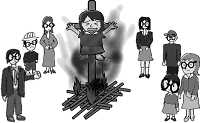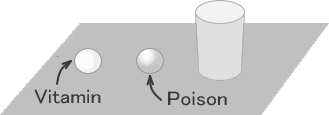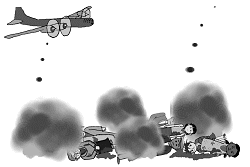Psychology and good & evil
The terms 'illusions of good and evil' and/or 'good & evil addiction' do not seem to be widely recognized in the world of psychology.
The term good and evil is somewhat associated with ethical or religious practices rather than psychological studies.
However, once you leave the world of ethics and its criteria of discriminating between what's good and what's bad, and pick up just the concept of good and evil,
you can observe how this concept easily causes illusions in the human mind.
If you look deeper within the human psyche, you may also be able to understand the precarious nature of such illusions.
The illusions of good and evil not only cause conflicts within individual minds but have also been a root cause of various human tragedies on earth including wars, terrorism, oppression, murders, crimes and abuse for thousands of years.

Unless people become aware of the existence of illusions created by good and evil and cure this mental illness called good and evil addiction, human beings will continue to fight each other forever.
Further more, unless you take into account the illusions and the compulsive obsessive disorders of good and evil,
it is hard to deepen the understanding of the psychology of various human behaviors such as criminal psychology, multiple personality etc.
Unfortunately there are few people who are aware of the illusions of good and evil yet many are exposed to its risk and are oblivious to them. Under such circumstances, it is no wonder that crimes, terrorism, wars and abuse are almost impossible to prevent.
Then what are these illusions that emerge from good and evil?
Unfortunately, it is not easy to pinpoint exactly what they are.
Needless to say, illusions occur when something is perceived incorrectly.
The reason why one may form such incorrect perceptions may simply be due to the fact that it is easy to make mistakes
and that there are reasons that leads us to make mistakes.
Basically,
- *Avoiding mistakes when it is easy to make mistakes
- and
- *Avoiding mistakes when there is reason to make mistakes
I will explain this with a concrete example.
Imagine there is a white tablet, an off-white tablet and a glass filled with water on a table.
Assume that the white one is a vitamin and the off-white one poison.

Now compare the white tablet and the glass.
No matter who sees them, they are two different objects. The size and shape are distinctively different.
As it is easy to distinguish between the two, it is easy not to mistake them for what they are.
Therefore no illusions are created.
Nobody swallows the glass by mistake if asked to take the white tablet as it is a vitamin supplement.
However, the white tablet and the off-white tablet are similar in appearance, meaning they are easily mistaken.
If the room is dark and one isn't aware that there are two kinds of tablets, then there are reasons for a mistake to arise.
It is vital to distinguish the difference between the white and off-white tablet as it may be life threatening, but it can be very difficult to explain and perceive this difference.

In another words, it is difficult to explain and perceive illusions, no matter how important the issue is.
Even if the issue is a matter of great significance such as the question of achieving eternal world peace
or the ongoing nature of wars, the difficulty of perceiving illusions is inherent.
Furthermore, the term/concept of good and evil governs the human psyche at a subconscious level.
It forms a huge complex web in the human mind.
Let me elaborate on this.
Have you ever heard that it is difficult for humans to perceive air, as it is for fish to perceive water?
We are mostly oblivious to the presence of air if there is no wind.
There is a saying that some people 'cannot see the wood for the trees'.
Isaac Newton discovered the gravity that surrounds us and consequently became famous for this discovery.
In other words, once you enter or are engulfed by something, it is easy to be unaware of it
and thereby it is hard to take an objective view of it.
Similarly, it is very difficult for humans who live in a world of good and evil,
to take an objective view of good and evil.
Let's try a simple experiment.
How do you find the following conversation?
- "Did you know that good and evil is extremely dangerous?"
- "Really? Then is it better not to use the term good and evil?"
How did you interpret this conversation? Did you feel any sense of discomfort? Now look at the next conversation.
- "Did you know that good and evil is extremely dangerous?"
- "Really? Then is it bad (evil) to use the term good and evil?"
Do you see the irony in this?
Were you aware of the ever-present presence of good and evil that is embedded deep in one's mind?
(N.B By saying "something is bad" one is already attesting to the presence of good and evil.)
In order to take an objective view of the hard working nature of good and evil,
one needs to explore deeper into the mind.
The 'Peace Picture book' movement and Good and Evil Addiction
Aforementioned, the illusion of good and evil is extremely dangerous. (Please see our picture books for examples)
To reiterate, the illusions of good and evil provide breeding grounds for most of the conflicts apparent in our world today including wars and terrorism. In drawing an analogy between the above experiment and our own world, those many who consumed the off-white tablet (poison) instead of the white tablet (vitamin) due to illusion, would have consequently suffered and lost their lives.
Therefore, spreading awareness about the risk of the illusion of good and evil is directly linked to the development of world peace. The acts of terrorism and/or wars created by the illusions of good and evil can be reduced and prevented by sharing the information and by removing the illusions that nest in people's mind.
Consequently we have started this movement of 'Peace Picture Books' to let people in the world know the danger of good and evil. (There are clear reasons why picture books are used for this purpose. Please visit this page - Why picture books for world peace?)
Needless to say, just reading our picture books is not enough to perceive the illusions accurately or to view good and evil objectively. However we hope that these picture books may work as a trigger for readers to start thinking about the hidden awful risk.
And we believe that this will be the first step to stop the spinning of the whirlpool of conflicts (=conflicts of good and evil) that human beings keep fighting almost eternally.
'Good and Evil Addiction' was written as a basic theory book of 'Peace Picture book' movement.
We believed that a core book was needed, if we wanted to develop this movement in the future.
On the other hand, our picture books are for the actual practice of this movement.
Book; Good and Evil Addiction - Psychology of illusion that causes wars, terrorism, abuses, various conflicts…
Referring to the above mentioned example,
the book was written with the intention of discriminating accurately the white tablet from the off white tablet even in the dark room.
The mechanism of the illusions is explained in detail in the book. Many pictures and charts are used in the book to help readers to understand the theme from both of words and images.
I have made my best efforts to write the manuscript in very plain words for the readers to understand it as easily as possible,
but the theme of the book is about human psychology that is not visible.
Further more the main theme is about illusions that are difficult to comprehend in the first place.
Therefore I am afraid that the book is not very easy to comprehend. It is certainly not for passing time.
This does not mean you need high IQ to read the book. Reader's IQ is not a relevant matter.
You don't need special knowledge about psychology.
What you need is flexible open mind.
Thus no matter how good your brain is; if you tend to oppress your mind or emotions, then you may not be able to comprehend this book.
It is almost impossible for that kind of people to understand my book.
(That's why I have written picture books for them.)
In another words, it is not easy to take away illusions from someone who depends on the illusions.
 The first 30 pages of Good and Evil Addiction in English
The first 30 pages of Good and Evil Addiction in English

